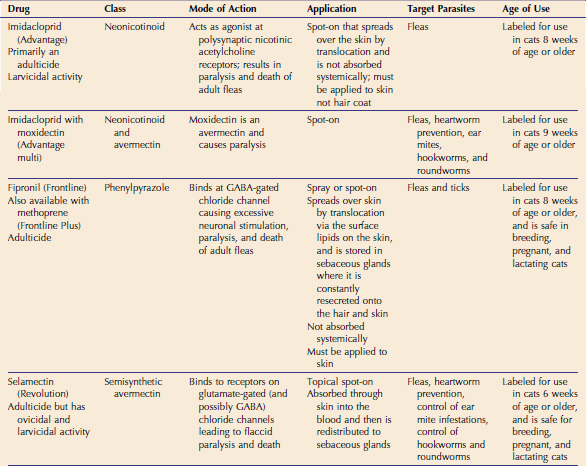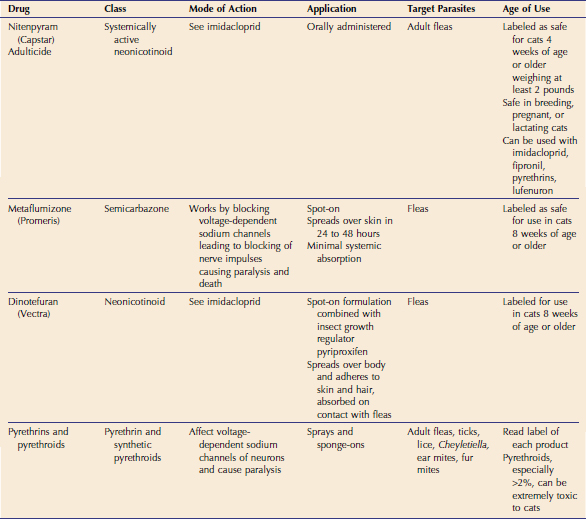CHAPTER 37 How to Treat Common Parasites Safely
FLEAS
It is important to note that the cat flea has broad host specificity and also will readily accept dogs, ferrets, rabbits, opossums, and raccoons as hosts.1 Under ideal conditions the entire flea life cycle can be completed in as little as 14 days, or can be delayed by 6 months. It also is important to note that adult fleas represent only 5 per cent of the entire flea population, whereas the immature life cycle stages (eggs, larvae, and pupae) represent the vast majority (95 per cent) of the population.
The concept of integrated pest management is advocated as the most effective way to eliminate existing flea populations quickly as well as prevent reinfestations. Integrated pest management involves the routine use of flea adulticides on the pet to eliminate the most visible part of the flea infestation, as well as control of egg and larval populations in the environment. Both on-pet and premise products are available to control immature stages of the flea life cycle. The preemergent adult fleas within their protective cocoons are the stage most resistant to destruction by any means. Integrated pest management also should provide the added benefit of delaying the development of resistance to the newer insecticides that are so valuable to us. The convenience and outstanding effectiveness of the newer insecticides may tempt the clinician into forgoing good client education and the principles of integrated pest management, but we must avoid this trap if we wish to preserve the effectiveness of these new insecticides (Table 37-1).
In addition to knowledge of flea biology, proper client education concerning the new flea control products also is important. Misconceptions regarding these newer flea control products are common. Many pet owners think that these products repel adult fleas, and therefore assume fleas have become resistant to a product if they see any fleas on their pet during the month after application of the product. In reality they are not seeing resistant fleas, but rather newly hatched adults that have developed from already existing immature stages in the environment. Complete eradication of the entire flea population takes time. Current extensive monitoring efforts have not detected any field collected strains of fleas resistant to imidacloprid,2 although the KS1 laboratory strain of fleas has demonstrated some reduced susceptibility to various insecticides, including imidacloprid and fipronil.3,4 Only one isolate of fleas collected in 1998 from Florida has shown some reduced susceptibility to fipronil.4
INSECTICIDES/ADULTICIDES
Imidacloprid
Imidacloprid (Advantage) was the first newer generation insecticide released for control of fleas in 1996. It is a topical spot-on that spreads over the skin by translocation and is not absorbed systemically. It is a neonicotinoid (chloronicotinyl nitroguanidine) that acts as an agonist on the postsynaptic nicotinic acetylcholine receptors. By keeping the receptor channels open, it causes constant neuronal stimulation and therefore paralysis and death of adult fleas. Imidacloprid has a very high margin of safety as a result of the affinity of the compound for insect acetylcholine receptors over mammalian acetylcholine receptors. Imidacloprid is absorbed through the flea intersegmental membranes and does not require ingestion by the flea to be effective.5
Imidacloprid kills adult fleas rapidly, with 100 per cent efficacy achieved within 12 to 24 hours after application.6 Efficacy decreases slightly by 28 days after application, with 90 to 96 per cent of newly applied fleas killed in 24 hours.7 One earlier study showed that imidacloprid’s efficacy decreased to below 100 per cent by approximately 3 weeks after application, and that some viable eggs were produced after this time period.3 Therefore initial application of imidacloprid every 3 weeks may be beneficial for the very flea-allergic cat. Imidacloprid also has good larvicidal activity,8 although the principles of integrated pest management would discourage the use of a single chemical as both an adulticide and a larvicide. Imidacloprid is labeled for use in cats 8 weeks of age and older, and can be administered as often as once a week. The label recommends following veterinary advice for use on debilitated, aged, pregnant, or lactating cats.
Fipronil
Fipronil (Frontline) was introduced shortly after imidacloprid in 1996. It is a phenylpyrazole insecticide with activity against adult fleas and ticks. It binds at the GABA-gated chloride channel, causing excessive neuronal stimulation, paralysis, and death of adult fleas. Some evidence suggests it is the glutamate-gated chloride channels that are affected rather than the GABA-gated chloride channels. Fipronil’s high affinity for insect receptors over mammalian receptors is responsible for its safety in animals. Fipronil kills insects by contact or by ingestion.9 It is available as a spray (Frontline spray), as a spot-on formulation (Frontline Top Spot), and in combination with the insect growth regulator methoprene as the spot-on formulation Frontline Plus.
Fipronil spreads over the skin by translocation via the surface lipids on the skin and is stored in the sebaceous glands from where it is constantly resecreted onto the skin and hair. It is not absorbed systemically. Because of its dependence on the skin surface lipid layer, many dermatologists recommend that fipronil be applied 24 to 48 hours before or after bathing, because bathing can disrupt the surface lipid layer. Fipronil reaches 100 per cent flea kill by 24 hours after application; however, like imidacloprid, efficacy decreased to below 100 per cent by 3 to 4 weeks after application, allowing some viable egg production.3 Viable egg production is prevented by the methoprene in Frontline Plus. These data indicate that some extremely flea-allergic cats may not have adequate flea control with fipronil alone for the full 4 weeks. Unfortunately fipronil is an EPA-registered product, and clinicians are advised that it is a violation of federal law to deviate from the label instructions stating the product should not be reapplied before 30 days. The authors are aware of cases in which fipronil has been used more frequently (e.g., every 3 weeks) without any adverse effects. Clinical trials have demonstrated the effectiveness of fipronil in reducing the clinical signs of flea-allergy dermatitis in cats.10 It is labeled for use in cats 8 weeks and older, and is safe for use in breeding, pregnant, and lactating cats.
Selamectin
Selamectin (Revolution) was introduced in 1999. It is a semisynthetic avermectin derived from a bioengineered strain of Streptomyces avermitilis. Selamectin binds to receptors on glutamate-gated (and possibly GABA-gated) chloride channels, leading to flaccid paralysis and death of parasites. Selamectin’s greater affinity for insect chloride channel receptors accounts for its safety in animals. Selamectin is a topical spot-on formulation that is absorbed through the skin into the blood and then is redistributed to the sebaceous glands. Selamectin achieves 100 per cent flea kill by 24 hours after application6; however, by 28 days after application, flea kill has decreased to less than 100 per cent.6,11 Selamectin also has ovicidal and larvicidal activity, but as with imidacloprid, principles of integrated pest management would discourage use of a single product as an adulticide and larvicide. Selamectin has been shown to decrease clinical signs in flea-allergic cats when applied monthly.12 Although some reports demonstrated slower flea kill by selamectin compared with other flea adulticides, selamectin was shown to decrease flea feeding more than imidacloprid or fipronil.13
In cats selamectin is labeled for the control of flea infestations, prevention of heartworm disease caused by D. immitis, control of ear mite (O. cynotis) infestations, and control of the intestinal parasites A. tubaeforme and T. cati. Selamectin can be used in cats 6 weeks of age and older. It also is safe for breeding, pregnant, and lactating cats. Adverse events are infrequent. As with all topical spot-on flea control products, local irritant reactions at the site of application have been reported. Rare instances of vomiting, loose stool, anorexia, lethargy, tachypnea, and muscle tremors also have been reported. Selamectin has been reported to be effective against Cheyletiella spp. when used once monthly for 3 months,14 and for Notoedres cati when used every 2 weeks for three applications.15
Stay updated, free articles. Join our Telegram channel

Full access? Get Clinical Tree




